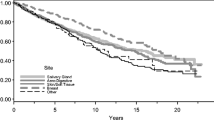Abstract
Objective
Acinar cell carcinoma (ACC) is an extremely rare cancer of the pancreas, accounting for less than 1 % of non-endocrine pancreatic tumors. The role for adjuvant radiation therapy (RT) in the management of this disease is unknown.
Methods
The Survival, Epidemiology, and End Results 18 database, November 2012 submission, was queried for ACC of the pancreas reported between the years of 1998 and 2010. Baseline characteristics were compared with the chi-squared test. Overall survival (OS) and cause-specific survival (CSS) were estimated using the Kaplan–Meier method. Cox proportional hazard modeling was performed for multivariate analysis of factors associated with OS and CSS. Analyses were performed using SPSS, version 20.
Results
Two hundred nineteen patients with acinar cell carcinoma were identified. Median follow-up was 11 months. Median patient age was 66 (range 4–92). One hundred fourteen patients (52.1 %) had locoregional disease, while 105 patients (47.9 %) had metastatic disease at diagnosis. Median OS for all patients was 14 months (95 % confidence interval (CI) 9.24–18.77 months), and median CSS was 17 months (95 % CI 10.37–23.63 months). For patients with non-metastatic disease, median OS was 38 months (95 % CI 28.43–47.57). Among patients with non-metastatic disease, the use of adjuvant radiation was associated with increased median OS (56 months [95 % CI 21.67–90.33]), compared to patients not treated with radiation (27 months [95 % CI 4.06–49.94]), p = 0.046. Use of adjuvant radiation was associated with increased cause-specific survival (66 vs. 40 months), but this was not statistically significant (p = 0.104). On multivariate analysis, use of surgery and adjuvant radiation were both associated with improved OS for patients with non-metastatic disease (hazard ratio (HR) 0.517, p = 0.034 and HR 0.423, p = 0.009, respectively). Both surgery and radiation were associated with non-statistically significant improvement in ACC cause-specific survival, HR = 0.606 (95 % CI = 0.314–1.170), p = 0.136 and HR = 0.501 (95 % CI = 0.249–1.009), p = 0.053, respectively.
Conclusion
Surgical resection with curative intent followed by adjuvant RT is associated with excellent long-term overall survival in patients with non-metastatic local-regional acinar cell carcinoma of the pancreas.




Similar content being viewed by others

References
Wisnoski NC, Townsend CM Jr, Nealon WH, Freeman JL, Riall TS (2008) 672 patients with acinar cell carcinoma of the pancreas: a population-based comparison to pancreatic adenocarcinoma. Surgery 144(2):141–8
Kitagami H, Kondo S, Hirano S, Kawakami H, Egawa S, Tanaka M (2007) Acinar cell carcinoma of the pancreas: clinical analysis of 115 patients from Pancreatic Cancer Registry of Japan Pancreas Society. Pancreas 35(1):42–6
Schmidt CM, Matos JM, Bentrem DJ, Talamonti MS, Lillemoe KD, Bilimoria KY (2008) Acinar cell carcinoma of the pancreas in the United States: prognostic factors and comparison to ductal adenocarcinoma. J Gastrointest Surg 12(12):2078–86
Seth AK, Argani P, Campbell KA et al (2008) Acinar cell carcinoma of the pancreas: an institutional series of resected patients and review of the current literature. Journal of Gastrointestinal Surgery: Official Journal of the Society for Surgery of the Alimentary Tract 12(6):1061–7
Lowery MA, Klimstra DS, Shia J et al (2011) Acinar cell carcinoma of the pancreas: new genetic and treatment insights into a rare malignancy. Oncologist 16(12):1714–20
Nishimizu T, Minemura M, Kajiura S et al (2011) A case of pancreatic acinar cell carcinoma with a giant liver metastasis successfully treated with combination of gemcitabine and peroral S-1. Gan To Kagaku Ryoho Cancer Chemother 38(2):309–12
Lee JL, Kim TW, Chang HM et al (2003) Locally advanced acinar cell carcinoma of the pancreas successfully treated by capecitabine and concurrent radiotherapy: report of two cases. Pancreas 27(1):e18–22
Robertson JC, Eeles GH (1970) Syndrome associated with pancreatic acinar cell carcinoma. Br Med J 2(5711):708–9
Network NCC (2013) NCCN clinical practice guidelines in oncology: pancreatic adenocarcinoma, Version 1. NCCN, Fort Washington
Raman SP, Hruban RH, Cameron JL, Wolfgang CL, Kawamoto S, Fishman EK (2013) Acinar cell carcinoma of the pancreas: computed tomography features—a study of 15 patients. Abdom Imaging 38(1):137–43
Chen CP, Chao Y, Li CP et al (2001) Concurrent chemoradiation is effective in the treatment of alpha-fetoprotein-producing acinar cell carcinoma of the pancreas: report of a case. Pancreas 22(3):326–9
Distler M, Ruckert F, Dittert DD et al (2009) Curative resection of a primarily unresectable acinar cell carcinoma of the pancreas after chemotherapy. World J Surg Oncol 7:22
Yamamoto T, Ohzato H, Fukunaga M, Imamura H, Furukawa H (2012) Acinar cell carcinoma of the pancreas: a possible role of S-1 as chemotherapy for acinar cell carcinoma. A case report. JOP: J Pancreas 13(1):87–90
Matos JM, Schmidt CM, Turrini O et al (2009) Pancreatic acinar cell carcinoma: a multi-institutional study. J Gastrointest Surg 13(8):1495–502
Butturini G, Pisano M, Scarpa A, D'Onofrio M, Auriemma A, Bassi C (2011) Aggressive approach to acinar cell carcinoma of the pancreas: a single-institution experience and a literature review. Langenbeck's Archives of Surgery/Deutsche Gesellschaft fur Chirurgie 396(3):363–9
Hartwig W, Denneberg M, Bergmann F et al (2011) Acinar cell carcinoma of the pancreas: is resection justified even in limited metastatic disease? Am J Surg 202(1):23–7
Conflict of interest
David Horowitz declares that he has no conflict of interest. Paul Oberstein declares that he has no conflict of interest. Daniela Gidea-Addeo declares that she has no conflict of interest.
Ethical statement
All procedures followed were in accordance with the ethical standards of the responsible institutional review board of Columbia University and with the Helsinki Declaration of 1975, as revised in 2008.
Author information
Authors and Affiliations
Corresponding author
Rights and permissions
About this article
Cite this article
Horowitz, D.P., Oberstein, P.E. & Gidea-Addeo, D. Use of adjuvant radiation therapy in the management of acinar cell carcinoma of the pancreas: results from the Survival, Epidemiology, and End Results database. J Radiat Oncol 3, 299–306 (2014). https://doi.org/10.1007/s13566-014-0151-x
Received:
Accepted:
Published:
Issue Date:
DOI: https://doi.org/10.1007/s13566-014-0151-x



